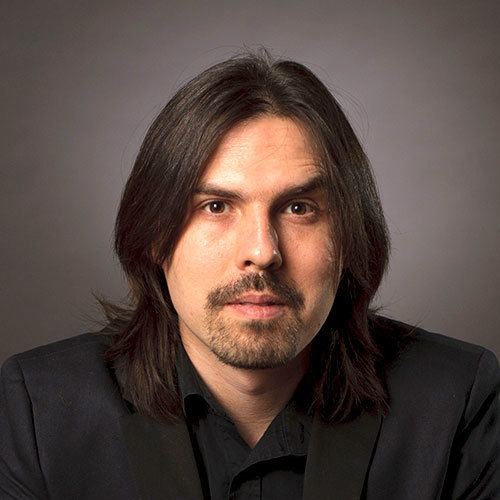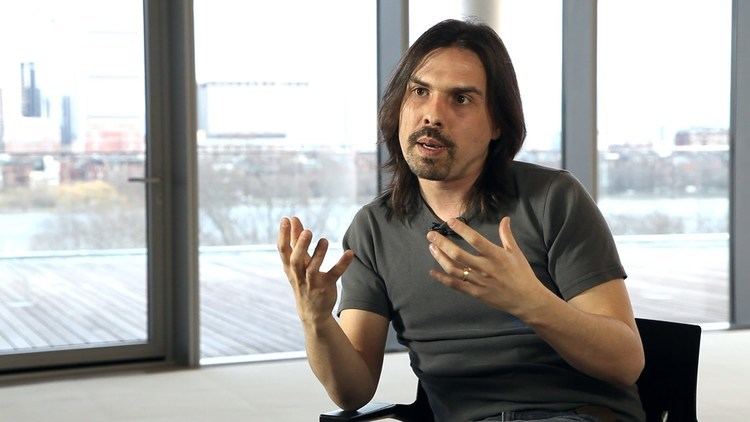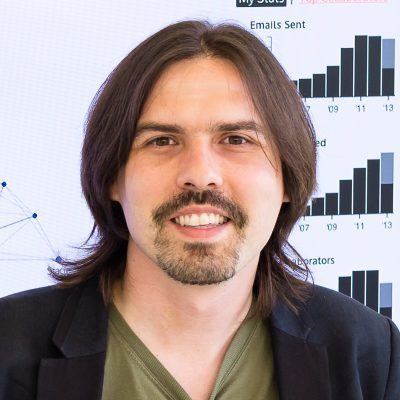Nationality Chilean Doctoral advisor Albert-László Barabási People also search for Ricardo Hausmann | Institutions MIT Alma mater University of Notre Dame | |
 | ||
Born Cesar Augusto Hidalgo Ramaciotti
December 22, 1979 (age 37)
Santiago, Chile ( 1979-12-22 ) Thesis Three empirical studies on the aggregate dynamics of humanly driven complex systems (2008) Known for The Atlas of Economic Complexity, ‘’The Product Space’’, Economic complexity index’’,Why Information Grows' Notable awards Bicentennial Medal from the Chilean Congress (2012) Books Why Information Grows: The Evolution of Order, from Atoms to Economies Fields Complexity economics, Complex systems, Network science, Data visualization Institution Massachusetts Institute of Technology | ||
César A. Hidalgo (born December 22, 1979) is a Chilean statistical physicist, writer, and data visualization designer. He is an Associate Professor of Media Arts and Sciences at MIT and the director of the Macro Connections group at The MIT Media Lab. Hidalgo is the author of Why Information Grows, and co-author of The Atlas of Economic Complexity. Hidalgo is known for pioneering the field of Economic Complexity and for the creation of several popular Data Visualization Engines, such as The Observatory of Economic Complexity, DataViva, Pantheon, Immersion, and DataUSA. He has received the Bicentennial Medal of Science from the Chilean Congress and was selected as a World Economic Forum young global leader. Wired Magazine UK also named him as one of 50 people who could change the world in 2012.
Contents
- Early life and education
- Economic complexity
- Why Information Grows
- Data visualization
- The Observatory of Economic Complexity OEC
- DataViva
- Pantheon
- Immersion
- Place Pulse and Streetscore
- Data USA
- References

Early life and education
Hidalgo was born in Santiago de Chile in 1979 to Cesar E. Hidalgo and Nuria Ramaciotti. His father was a publicist and journalist and his mother an accountant. He has two siblings Caterina and Nuria.

Hidalgo attended The Grange School until the age of fourteen, but completed his High School Education at Santiago’s The British High School. From 1998 to 2003 he studied Physics at Universidad Catolica de Chile and from 2004 to 2008 he obtained a PhD in Physics from The University of Notre Dame. His PhD advisor was Albert-Laszlo Barabasi.

In 2010 Hidalgo joined The MIT Media Lab as an Assistant Professor and was promoted to Associate Professor in 2014. He directs the Macro Connections group at The MIT Media Lab.
Economic complexity

Starting in 2006 Hidalgo began using networks to study the process of economic development. His main contributions include The Product Space, which is a network that can be used to predict a country’s future patterns of diversification, and the economic complexity index, a formula that can be used to estimate the computational capacity of economies and that is highly predictive of future economic growth. Hidalgo’s work in Economic Complexity has been covered by important media outlets like The New York Times, The Economist, and The Financial Times.
Why Information Grows
In Why Information Grows Hidalgo explains economic growth as a side effect of the growth of information and computation in the universe. He begins by explaining the physical mechanisms that allow information to grow, and then unpacks these mechanisms in the context of social and economic systems. The main argument of the book is that the need for computation to be embodied, in cells, humans, or teams of humans, is what makes the growth of information in the economy both possible and difficult.
Soon after its release the book was highly praised by economists including Paul Romer, the father of endogenous growth theory, Eric Beinhoecker, the director of Oxford’s Institute for New Economic Thinking, and Tim Harford, a popular economics author and regular columnist for The Financial Times. Why Information Grows was also featured as the main review of The Economist's books and arts section of the July 25, 2015 print edition, as the main book review of Nature's May 28, 2015 print edition, and Kirkus Reviews, among others.
Data visualization
Hidalgo has co-authored a number of popular data visualization engines. These are tools that make available vast volumes of data through visualizations. These visualization engines include:
The Observatory of Economic Complexity (OEC)
The OEC is a tool that makes available international trade data for the last 50 years through more than 20 million visualizations. The Observatory of Economic Complexity focuses on the mix of products that countries export because this product mix is predictive of a country's future patterns of diversification, G.D.P. growth, and income inequality. The OEC was co-authored with Alex Simões, who developed this platform as his master thesis in the Macro Connections group at The MIT Media Lab.
DataViva
DataViva is a visualization engine that makes available regional development data for all of Brazil through more than 1 billion visualizations. These visualizations include trade data, employment data and education data, for each of Brazil's more than 5000 municipalities and its hundreds of products, industries and occupations. DataViva was developed in a collaboration between Hidalgo, Alex Simões and Dave Landry, and the government of Minas Gerais in Brazil, including Minas’s government department of strategic priorities and FAPEMIG, Minas Science funding agency.
Pantheon
Pantheon is a data visualization engine focused on historical cultural production and impact. Pantheon helps users explore metadata on globally famous biographies as a mean to understand the process of collective memory and of the role of languages and communication technologies in the production and diffusion of cultural information. Amy Yu, Kevin Hu, and Cesar Hidalgo developed pantheon at the Macro Connections group at MIT
Immersion
Immersion is a data visualization engine for email metadata. Immersion helps uncover the networks people form while interacting through email. Immersion was co-authored by Hidalgo together with Daniel Smilkov and Deepak Jagsdish, while both Smilkov and Jagdish were working as students in Hidalgo’s Macro Connection’s group. Immersion was released in 2013, and quickly became popular as a way to demonstrate what people can learn by looking only at email metadata.
Place Pulse and Streetscore
Place Pulse and Streetscore are tools to create high-resolution maps of people's perceptions of urban environments. These maps have been shown to correlate with crime levels, but also we are now using them to create computer vision tools that help us study urban change. Place Pulse has been featured in The Guardian and Fast Company. Streetscore has been featured in The Economist and New Scientist, among others.
Data USA
DataUSA is an effort to visualize and search engine optimize public data for the United States. It was launched on April 4, 2016 and acclaimed by The New York Times, The Atlantic's City Lab, and Fast Company. DataUSA received the Information is Beautiful Award in 2016.
